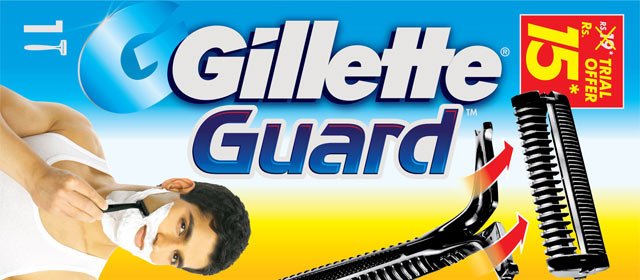I love innovation and inexpensive innovations more so. So this headline ‘Cheap razor made after P&G watches Indians shave‘ obviously got me clicking and half way through the story it occurred to me that this was about a razor that I have myself used and because of this first-hand experience I thought that what the story needed was a little myth-busting.
First to point out a little conflict of figures in the story itself. Towards the beginning of the story, Mae Anderson, the national consumer products and marketing reporter at the Associated Press, says, “Guard quickly gained market share and today represents two out of every three razors sold in India.” Two out of every three calculates to 66.66%. The story ends with a bunch of figures paint a very different picture: “P&G says with 9% market share, Guard has grown share faster than any other P&G brand in India.” 9% is not two out of three. No, not even in India.
When I noticed a single-blade razor didn’t look like a single-blade razor on a supermarket shelf I instinctively put it in the trolley. The next morning, I applied a little more lather as I hadn’t shaved with a single-blade in quite a while and wanted the stubble to soften up a little more for the Gillette Guard. My effort didn’t seem to be of much help. It was one of the more uncomfortable shaves that I have had in a long time. The double-edged Topaz blades, even though they are more prone to draw blood than the Guard, surely gave a much smoother shave. The razor that I had so gleefully put into my supermarket trolley soon went into the bin.
I know I am not the intended customer for the Guard (Procter & Gamble would rather want me to buy something more blades than there are people in my household), but I have experienced the conditions the people for whom this razor has been ‘invented’. Growing up in a perennially water-scarce hill city, running water was a luxury that even the rich couldn’t afford. So for the first six years of my shaving life, it was a only mug of water to rinse the razor (I still prefer a mug over running water). Clogging is definitely an issue with multiple blades but a vigorous shake of the razor in a mug of clean water usually does the job.
“They even made the razor’s handle hollow so it would be lighter and cheaper to make.” This isn’t as great an innovation as it might appear to a reader unaccustomed to the razors found in an Indian store shelf. Hollow handles are a standard for the inexpensive versions.
Also the Gillette Guard is a little more expensive than it appears to be in the AP story. The Rs 15 followed by Rs 5 for refills were the introductory prices and the razor and the cartridges now sell for Rs 19 and Rs 7 (unless P&G has another offer running). Gillette’s less glorified competitors sell twin-blade cartridges for about Rs 7 a piece and triple-blades for about Rs 10, but they may not be as ‘India-friendly’ as P&G claims the Gillette Glide to be.
P&G’s strategy (that is also followed in the desktop printer business) of selling the razor handles (with a cartridge or two thrown in) cheap and later making money with expensive cartridge sales had me ensnared for some time. But I have managed to break free and now use a triple-blade disposable razor that offers me comfort and number of shaves comparable to the Gillette Mach 3 at a fraction of its price. That’s my innovation.




I guess the 2 of 3 is for volume market share (I don’t believe the numbers though), while the 9% is by value. Lot of volumes in the cheaper market do not help value market share.
@Goyal You are right, it could be.
Even if I find much of Gillette’s products immoderately priced, there’s no one worthy competitor. Gillette has almost become as synonymous with shaving as Amul with butter.
You will enjoy this